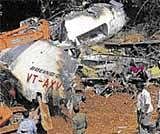

Disclosing this to Deccan Herald over phone Director General of Civil Aviation S N A Zaidi said that the two vital equipment––the digital flight data recorder (DFDR), otherwise known as the black box, and the CVR––were in good condition, but a decision has nevertheless been taken to hand them over to the NTSB. Other DGCA sources, however, said that the two important gadgets have been badly damaged.
In Zaidi’s view, the NTSB would handle the two crucial components competently so that there is “better data protection”. The decision to send the CVR and DFDR to the NTSB might have been necessitated by the understanding that since Boeing, the manufacturer, is based in the US, it could have international legal implications.
Previous instances
The NTSB has previously been involved in conducting detailed investigations whenever aircraft manufactured by Boeing, Bombardier and Airbus have been involved in fatal and non-fatal air crashes across the globe.
The government’s decision, in part, could have been motivated by the presence of an NTSB team led by the agency’s senior safety investigator Joe Sedor who was designated as the US’ accredited representative.
The NTSB team, which reached Mangalore on Tuesday, included a flight operations expert, an aircraft systems specialist besides technical advisors from the Federal Aviation Administration and Boeing. The team had several rounds of meetings with DGCA officials.
Indicating that the government was exploring the possibility of getting the crash, one of the worst in India’s aviation history, investigated by an independent authority, Zaidi said: “Provisions in the Aircraft Rules, 1937, empower the government to establish an independent body to probe any accident or incident”.
Evidence
In the case of Flight IX-812, the investigation would be by a Court of Inquiry which would be assisted by persons possessing legal aeronautical, engineering or other special knowledge.
Once the transcripts and analyses of the CVR and the DFDR are returned by the NTSB, they would be presented before the Court, which would have all the powers of a civil court, as evidence.
The DGCA chief said given the gravity of the situation and the sensitive issues involved, he personally favoured an independent body to probe the crash. In this context, he defended the decision to send the CVR and the DFDR to the NTSB.
According to Zaidi, the first part of the investigation involved setting up an inspector of inquiry –– in this case DGCA’s air safety director Bir Singh Rai –– who was mandated to gather evidence, documentary and verbal, seal the written statements of Mangalore Air Traffic Control (ATC) officials, and search and recover the CVR and DFDR. Rai would be part of the investigation later when the Court of Inquiry begins its formal probe.
Other top DGCA sources told Deccan Herald that preliminary enquiries into the crash have “to some extent” established that the pilot flew in the aircraft over Mangalore airport “high and fast”.
The sources said that on a general level the initial probe indicated that although the pilot-in-command established contact with the ATC and received landing clearance, he flew in at an altitude which led to overshooting the runway by 2,000 feet. Besides, the aircraft's speed was much too high.